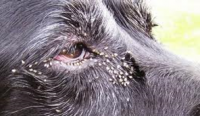Eye Gnats
Eye gnats are prevalent in the Southern United States, primarily in parts of California and Arizona. The adult eye gnats are non-biting insects. Their persistent buzzing around human and animal eyes classified them as nuisance insects that may cause economic losses by lowering performance of exposed, mostly agricultural, workers.

In the Coachella Valley, they have been a problem since agriculture was first introduced into the Valley. The most common species in the Coachella Valley is Hippelates collusor. They measure approximately 1.5 to 2.5 millimeters in length and are attracted to sebaceous secretions, pus, and blood.

The economical impact and magnitude of the eye gnat problem in the Coachella Valley prompted authorities to form the Coachella Valley Mosquito Abatement District in 1928. In the past, control methods included poison bait and different types of attractant baits that were placed primarily in agricultural fields. Since 1990, the District has used 8,000 to 10,000 traps per year filled with a nontoxic liquid egg bait to attract and remove eye gnats from agricultural areas and country clubs to reduce nucances of these pests.
Breeding Sources
Eye gnats are very common in warm, dry regions. The majority of eye gnats develop in light, well drained, sandy soils that are freshly plowed and contain abundant humus or vegetable matter (such as cover crops or manure), and sufficient moisture.
Life Cycle
Females get the protein necessary for egg production from exposed mucus. The eggs, about 0.5 millimeters in length, are deposited in batches of up to 50 on or below the surface of the soil. After two days, larvae will develop and feed on a variety of decaying organic matter. The larval stage, under optimum conditions, requires about 7 to 12 days, the pupal stage about 6 to 7 days, totaling approximately 21 days from egg to adult, or 28 days from egg to egg.
Eye gnats do not bite.
They swarm around the head with an annoying persistence, darting at the eyes, mouth, nose, or wounds of humans or other animals. Their labium contains a spine that helps introduce pathogenic organisms to the eye. In this way, eye gnats can aid in the transmission of acute bacterial conjunctivitis (pinkeye) and yaws to humans and anaplasmosi organisms to cattle.
You can prevent eye gnats around your home.
The best way to reduce a pest such as eye gnats it to reduce area in which they breed. Remove leaf litter, weeds, grass clippings and flowers before they decay. Reducing the amount of moisture or irrigation and keeping the surface soil dry will help reduce egg laying and larval survival.
You can create your own eye gnat trap at home by following the steps in the video above. Printable instructions
